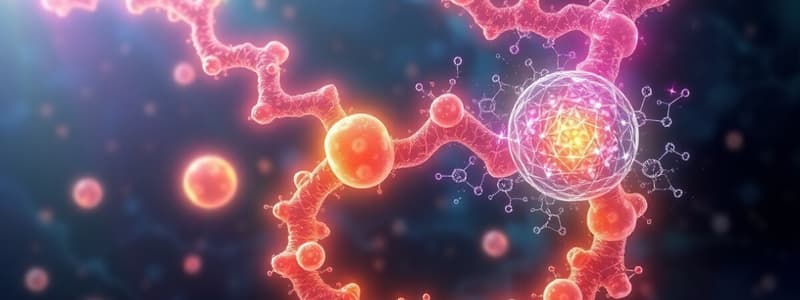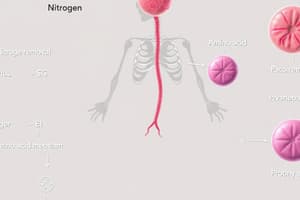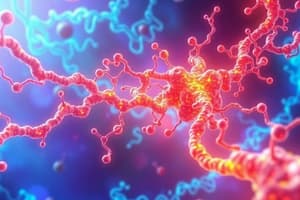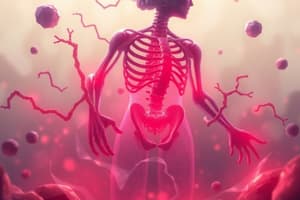Podcast
Questions and Answers
What is the primary mechanism through which nitrogen is disposed of from the body?
What is the primary mechanism through which nitrogen is disposed of from the body?
- Formation of urea (correct)
- Synthesis of amino acids
- Conversion to creatinine
- Release as free ammonia
Which of the following conditions is most likely to cause hyperammonemia?
Which of the following conditions is most likely to cause hyperammonemia?
- Increased energy expenditure
- High levels of glucose consumption
- Deficiency in urea cycle enzymes (correct)
- Excessive protein intake
What role does glutamine play in nitrogen metabolism?
What role does glutamine play in nitrogen metabolism?
- It is a storage form of amino acids.
- It is a precursor for glucose synthesis.
- It directly converts ammonia into urea.
- It carries ammonia to the liver for excretion. (correct)
Which of the following symptoms is commonly associated with ammonia intoxication?
Which of the following symptoms is commonly associated with ammonia intoxication?
Which strategy is primarily utilized for detoxifying ammonia in the body?
Which strategy is primarily utilized for detoxifying ammonia in the body?
What mechanism is primarily responsible for keeping blood ammonia levels low in the liver?
What mechanism is primarily responsible for keeping blood ammonia levels low in the liver?
Which condition can lead to hyperammonemia?
Which condition can lead to hyperammonemia?
What is the role of glutamine synthetase in ammonia detoxification?
What is the role of glutamine synthetase in ammonia detoxification?
Which of the following is NOT a symptom of ammonia intoxication?
Which of the following is NOT a symptom of ammonia intoxication?
When liver function is compromised, what level of blood ammonia is considered a medical emergency?
When liver function is compromised, what level of blood ammonia is considered a medical emergency?
What immediate effect does elevated ammonia concentrations have on the central nervous system?
What immediate effect does elevated ammonia concentrations have on the central nervous system?
Which substance combines with glutamine to help detoxify ammonia in the body?
Which substance combines with glutamine to help detoxify ammonia in the body?
What is the normal range for blood ammonia levels?
What is the normal range for blood ammonia levels?
Which component is essential for activating CPS I in the urea cycle?
Which component is essential for activating CPS I in the urea cycle?
What is the primary consequence of hyperammonemia on the central nervous system?
What is the primary consequence of hyperammonemia on the central nervous system?
How is ammonia primarily transported from peripheral tissues to the liver?
How is ammonia primarily transported from peripheral tissues to the liver?
Which factor does NOT contribute to the regulation of ammonia levels in the body?
Which factor does NOT contribute to the regulation of ammonia levels in the body?
What is the primary metabolic pathway that produces ammonia from amino acids?
What is the primary metabolic pathway that produces ammonia from amino acids?
Which clinical symptom is commonly associated with ammonia intoxication?
Which clinical symptom is commonly associated with ammonia intoxication?
What strategy is primarily employed for ammonia detoxification in the liver?
What strategy is primarily employed for ammonia detoxification in the liver?
What role does arginine serve in relation to N-acetylglutamate synthase?
What role does arginine serve in relation to N-acetylglutamate synthase?
In which condition is an increased production of ammonia most likely to occur?
In which condition is an increased production of ammonia most likely to occur?
Which of the following is NOT a function of glutamate in ammonia metabolism?
Which of the following is NOT a function of glutamate in ammonia metabolism?
What is the primary mechanism for ammonia removal in the central nervous system?
What is the primary mechanism for ammonia removal in the central nervous system?
Which process primarily disposes of ammonia produced in the liver?
Which process primarily disposes of ammonia produced in the liver?
What condition can arise from a buildup of ammonia in the blood?
What condition can arise from a buildup of ammonia in the blood?
Which amino acid is typically released by muscle to transport nitrogen instead of ammonia?
Which amino acid is typically released by muscle to transport nitrogen instead of ammonia?
What is a key reason for the low levels of ammonia in the blood?
What is a key reason for the low levels of ammonia in the blood?
What clinical symptoms can result from ammonia intoxication?
What clinical symptoms can result from ammonia intoxication?
Which tissue is primarily responsible for the synthesis of glutamine from glutamate and ammonia?
Which tissue is primarily responsible for the synthesis of glutamine from glutamate and ammonia?
What form of nitrogen do skeletal muscle and other tissues typically release?
What form of nitrogen do skeletal muscle and other tissues typically release?
Which of the following best describes the role of glutamine in the body?
Which of the following best describes the role of glutamine in the body?
How does the body primarily form ammonia from dietary amines?
How does the body primarily form ammonia from dietary amines?
What is the primary mechanism by which the body disposes of nitrogen from amino acids?
What is the primary mechanism by which the body disposes of nitrogen from amino acids?
Which condition is NOT a major cause of hyperammonemia?
Which condition is NOT a major cause of hyperammonemia?
In the context of amino acid metabolism, what role does glutamine play?
In the context of amino acid metabolism, what role does glutamine play?
Hyperammonemia can lead to neurologic effects primarily due to damage in which part of the body?
Hyperammonemia can lead to neurologic effects primarily due to damage in which part of the body?
What is the main consequence of ammonia not being detoxified effectively in the body?
What is the main consequence of ammonia not being detoxified effectively in the body?
Which enzyme deficiency is associated with congenital hyperammonemia?
Which enzyme deficiency is associated with congenital hyperammonemia?
What is the primary use of free ammonia in the human body?
What is the primary use of free ammonia in the human body?
Alanine functions primarily in what capacity regarding nitrogen transport?
Alanine functions primarily in what capacity regarding nitrogen transport?
Which of the following describes the main pathway for removing amino groups from amino acids?
Which of the following describes the main pathway for removing amino groups from amino acids?
Which clinical condition is primarily characterized by an accumulation of ammonia in the bloodstream?
Which clinical condition is primarily characterized by an accumulation of ammonia in the bloodstream?
What is the immediate consequence of argininosuccinate cleavage in the urea cycle?
What is the immediate consequence of argininosuccinate cleavage in the urea cycle?
Which statement accurately describes the transport and fate of urea after its synthesis?
Which statement accurately describes the transport and fate of urea after its synthesis?
What is the role of malate in the urea cycle and associated metabolic pathways?
What is the role of malate in the urea cycle and associated metabolic pathways?
Which enzyme exclusively cleaves arginine to yield ornithine and urea in the urea cycle?
Which enzyme exclusively cleaves arginine to yield ornithine and urea in the urea cycle?
What occurs to urea in the intestine after being transported from the blood?
What occurs to urea in the intestine after being transported from the blood?
What occurs to ornithine in the metabolic process described?
What occurs to ornithine in the metabolic process described?
What is the primary role of fumarase within this metabolic pathway?
What is the primary role of fumarase within this metabolic pathway?
What is synthesized from citrulline in the described process?
What is synthesized from citrulline in the described process?
What distinguishes short-lived proteins from long-lived proteins regarding their half-lives?
What distinguishes short-lived proteins from long-lived proteins regarding their half-lives?
In the mitochondria, which reaction involving ammonia is indicated?
In the mitochondria, which reaction involving ammonia is indicated?
Which enzyme system is primarily responsible for the selective degradation of damaged proteins?
Which enzyme system is primarily responsible for the selective degradation of damaged proteins?
Which amino acid is primarily involved in the transport of nitrogen as described in the process?
Which amino acid is primarily involved in the transport of nitrogen as described in the process?
What is the primary role of ubiquitin in the ubiquitin-proteasome system?
What is the primary role of ubiquitin in the ubiquitin-proteasome system?
What is the effect of increased ammonium ion concentration in the mitochondria?
What is the effect of increased ammonium ion concentration in the mitochondria?
How do lysosomes contribute to protein degradation?
How do lysosomes contribute to protein degradation?
Which type of proteins typically have half-lives measured in months or years?
Which type of proteins typically have half-lives measured in months or years?
What is required for the regeneration of fumurate in this pathway?
What is required for the regeneration of fumurate in this pathway?
Which product is generated when ammonia combines with other components in the mitochondrial matrix?
Which product is generated when ammonia combines with other components in the mitochondrial matrix?
What happens to nitrogen from amino acid degradation in the body?
What happens to nitrogen from amino acid degradation in the body?
What characterizes proteins targeted for degradation by the ATP-dependent ubiquitin-proteasome system?
What characterizes proteins targeted for degradation by the ATP-dependent ubiquitin-proteasome system?
What structural form does L-arginine take within the cellular process described?
What structural form does L-arginine take within the cellular process described?
What is the primary significance of citrulline in cellular metabolism as illustrated?
What is the primary significance of citrulline in cellular metabolism as illustrated?
What is the main role of E3 ligase in the ubiquitin-proteasome pathway?
What is the main role of E3 ligase in the ubiquitin-proteasome pathway?
Which of the following best describes the process of ubiquitination?
Which of the following best describes the process of ubiquitination?
What happens to proteins that are tagged with polyubiquitin chains?
What happens to proteins that are tagged with polyubiquitin chains?
What characterizes the proteasome's role in protein degradation?
What characterizes the proteasome's role in protein degradation?
Which of the following statements about ubiquitin is accurate?
Which of the following statements about ubiquitin is accurate?
How do degradation signals influence protein half-lives?
How do degradation signals influence protein half-lives?
Which type of enzymes has the highest diversity in the ubiquitin-proteasome system?
Which type of enzymes has the highest diversity in the ubiquitin-proteasome system?
What is the primary function of ATP in the ubiquitin-proteasome pathway?
What is the primary function of ATP in the ubiquitin-proteasome pathway?
In the context of protein degradation, what occurs after a protein is cut into fragments by the proteasome?
In the context of protein degradation, what occurs after a protein is cut into fragments by the proteasome?
Which of the following substances contributes to the formation of urea by providing a nitrogen atom?
Which of the following substances contributes to the formation of urea by providing a nitrogen atom?
What role does bicarbonate play in urea synthesis?
What role does bicarbonate play in urea synthesis?
In the context of urea formation, which biological process is most directly associated with free ammonia?
In the context of urea formation, which biological process is most directly associated with free ammonia?
Which compounds react to produce urea during the urea cycle?
Which compounds react to produce urea during the urea cycle?
Which of the following processes occurs in the liver as part of nitrogen metabolism?
Which of the following processes occurs in the liver as part of nitrogen metabolism?
How is the nitrogen in urea ultimately derived from aspartate?
How is the nitrogen in urea ultimately derived from aspartate?
Which molecule is primarily formed as a byproduct when ammonia is detoxified in the liver?
Which molecule is primarily formed as a byproduct when ammonia is detoxified in the liver?
Which enzyme plays a crucial role in the initial step of the urea cycle?
Which enzyme plays a crucial role in the initial step of the urea cycle?
What is the source of the ammonia that is involved in the formation of urea?
What is the source of the ammonia that is involved in the formation of urea?
During the urea synthesis process, which role does aspartate primarily serve?
During the urea synthesis process, which role does aspartate primarily serve?
Match the following processes with their corresponding descriptions:
Match the following processes with their corresponding descriptions:
Match the following nitrogen-containing products with their primary source:
Match the following nitrogen-containing products with their primary source:
Match the following amino acids with their roles in nitrogen metabolism:
Match the following amino acids with their roles in nitrogen metabolism:
Match the following terms with their meanings:
Match the following terms with their meanings:
Match the following stages of amino acid catabolism with their processes:
Match the following stages of amino acid catabolism with their processes:
Match the sources contributing to the amino acid pool with their descriptions:
Match the sources contributing to the amino acid pool with their descriptions:
Match the processes involved in amino acid pool depletion:
Match the processes involved in amino acid pool depletion:
Match the terms related to protein turnover with their definitions:
Match the terms related to protein turnover with their definitions:
Match the components involved in nitrogen metabolism:
Match the components involved in nitrogen metabolism:
Match the dietary protein source with its classification:
Match the dietary protein source with its classification:
Flashcards
Ammonia Metabolism
Ammonia Metabolism
The process by which the body removes ammonia, a toxic byproduct of protein breakdown.
Urea Cycle
Urea Cycle
A series of biochemical reactions in the liver that convert ammonia into urea, a less toxic compound, for excretion.
Hyperammonemia
Hyperammonemia
A medical condition characterized by excessively high levels of ammonia in the blood.
Blood Ammonia Levels
Blood Ammonia Levels
Signup and view all the flashcards
Ammonia Intoxication
Ammonia Intoxication
Signup and view all the flashcards
Hepatic Urea Cycle
Hepatic Urea Cycle
Signup and view all the flashcards
Urinary Urea Nitrogen (UUN)
Urinary Urea Nitrogen (UUN)
Signup and view all the flashcards
Blood Urea Nitrogen (BUN)
Blood Urea Nitrogen (BUN)
Signup and view all the flashcards
Ammonia Production
Ammonia Production
Signup and view all the flashcards
Low Blood Ammonia Levels
Low Blood Ammonia Levels
Signup and view all the flashcards
Urea Formation
Urea Formation
Signup and view all the flashcards
Glutamine Formation
Glutamine Formation
Signup and view all the flashcards
Glutamine's Function
Glutamine's Function
Signup and view all the flashcards
Monoamine Oxidase
Monoamine Oxidase
Signup and view all the flashcards
Glutamate's Role
Glutamate's Role
Signup and view all the flashcards
Ammonia Toxicity
Ammonia Toxicity
Signup and view all the flashcards
Urea Cycle Regulation
Urea Cycle Regulation
Signup and view all the flashcards
Source of Ammonia
Source of Ammonia
Signup and view all the flashcards
NAG Role in Urea Cycle
NAG Role in Urea Cycle
Signup and view all the flashcards
Ammonia Disposal
Ammonia Disposal
Signup and view all the flashcards
Amino Acid Catabolism
Amino Acid Catabolism
Signup and view all the flashcards
Ammonia excretion
Ammonia excretion
Signup and view all the flashcards
Glutamine Formation
Glutamine Formation
Signup and view all the flashcards
Nitrogen Disposal
Nitrogen Disposal
Signup and view all the flashcards
Urea Synthesis
Urea Synthesis
Signup and view all the flashcards
Urea Synthesis
Urea Synthesis
Signup and view all the flashcards
Alanine role in nitrogen disposal
Alanine role in nitrogen disposal
Signup and view all the flashcards
Amino Acid Source
Amino Acid Source
Signup and view all the flashcards
a-amino groups
a-amino groups
Signup and view all the flashcards
Hyperammonemia causes
Hyperammonemia causes
Signup and view all the flashcards
Amino acid degradation
Amino acid degradation
Signup and view all the flashcards
Ammonia
Ammonia
Signup and view all the flashcards
a-keto acids
a-keto acids
Signup and view all the flashcards
Amino acid synthesis
Amino acid synthesis
Signup and view all the flashcards
Dietary protein degradation
Dietary protein degradation
Signup and view all the flashcards
Nitrogen-containing molecules
Nitrogen-containing molecules
Signup and view all the flashcards
Amino group transfer
Amino group transfer
Signup and view all the flashcards
Nitrogen source
Nitrogen source
Signup and view all the flashcards
Short-lived proteins
Short-lived proteins
Signup and view all the flashcards
Long-lived proteins
Long-lived proteins
Signup and view all the flashcards
Structural proteins
Structural proteins
Signup and view all the flashcards
Ubiquitin-proteasome system
Ubiquitin-proteasome system
Signup and view all the flashcards
Lysosomes
Lysosomes
Signup and view all the flashcards
Protein Degradation Methods
Protein Degradation Methods
Signup and view all the flashcards
Malate to Fumerate
Malate to Fumerate
Signup and view all the flashcards
Ornithine Regeneration
Ornithine Regeneration
Signup and view all the flashcards
Citrulline Synthesis
Citrulline Synthesis
Signup and view all the flashcards
Citrulline Transport
Citrulline Transport
Signup and view all the flashcards
L-Arginine
L-Arginine
Signup and view all the flashcards
L-Ornithine
L-Ornithine
Signup and view all the flashcards
Urea Cycle Steps
Urea Cycle Steps
Signup and view all the flashcards
Ubiquitination Process
Ubiquitination Process
Signup and view all the flashcards
Polyubiquitin Chain
Polyubiquitin Chain
Signup and view all the flashcards
Proteasome
Proteasome
Signup and view all the flashcards
Protein Degradation Signal
Protein Degradation Signal
Signup and view all the flashcards
E1 Enzyme
E1 Enzyme
Signup and view all the flashcards
E2 Enzyme
E2 Enzyme
Signup and view all the flashcards
E3 Enzyme
E3 Enzyme
Signup and view all the flashcards
Ubiquitin
Ubiquitin
Signup and view all the flashcards
Urea formation
Urea formation
Signup and view all the flashcards
Amino acid breakdown
Amino acid breakdown
Signup and view all the flashcards
Ammonia disposal
Ammonia disposal
Signup and view all the flashcards
Glutamine formation
Glutamine formation
Signup and view all the flashcards
Nitrogen atoms in urea
Nitrogen atoms in urea
Signup and view all the flashcards
Free ammonia
Free ammonia
Signup and view all the flashcards
Source of nitrogen
Source of nitrogen
Signup and view all the flashcards
Urea Cycle
Urea Cycle
Signup and view all the flashcards
Ammonia
Ammonia
Signup and view all the flashcards
Argininosuccinate Cleavage
Argininosuccinate Cleavage
Signup and view all the flashcards
Arginine to Ornithine
Arginine to Ornithine
Signup and view all the flashcards
Urea Excretion
Urea Excretion
Signup and view all the flashcards
Arginase-1
Arginase-1
Signup and view all the flashcards
Urea's Fate
Urea's Fate
Signup and view all the flashcards
Amino Acid Catabolism
Amino Acid Catabolism
Signup and view all the flashcards
Nitrogen Disposal
Nitrogen Disposal
Signup and view all the flashcards
Ammonia
Ammonia
Signup and view all the flashcards
Urea Synthesis
Urea Synthesis
Signup and view all the flashcards
Urea Cycle
Urea Cycle
Signup and view all the flashcards
Amino Acid Source
Amino Acid Source
Signup and view all the flashcards
Free Ammonia
Free Ammonia
Signup and view all the flashcards
Nitrogen-containing molecules
Nitrogen-containing molecules
Signup and view all the flashcards
Amino Acid Pool
Amino Acid Pool
Signup and view all the flashcards
Protein Turnover
Protein Turnover
Signup and view all the flashcards
Amino Acid Pool Sources
Amino Acid Pool Sources
Signup and view all the flashcards
Amino Acid Pool Depletion
Amino Acid Pool Depletion
Signup and view all the flashcards
Protein Constant Amount (healthy adults)
Protein Constant Amount (healthy adults)
Signup and view all the flashcards
Dietary Protein Variation
Dietary Protein Variation
Signup and view all the flashcards
Study Notes
Amino Acids: Nitrogen Disposal
- Amino acids are not stored in the body; they must be obtained from diet, synthesized, or produced from body protein breakdown.
- Excess amino acids are degraded. This process begins by removing the amino group, forming ammonia and the corresponding a-keto acid.
- Ammonia is partially excreted in the urine, but mostly used in urea synthesis (a key way the body disposes of nitrogen).
- The second phase of amino acid catabolism involves the conversion of a-keto acids into common metabolic intermediates, yielding carbon dioxide, water, glucose, fatty acids, or ketone bodies.
- Amino acid catabolism is part of a larger nitrogen metabolism process, where nitrogen enters the body primarily as amino acids from dietary protein and exits as urea, ammonia, and related byproducts (like creatinine).
- The amino acid pool is a circulating pool of free amino acids in cells, blood, and extracellular fluids, a crucial part of protein synthesis.
- Protein turnover is the constant synthesis and breakdown of proteins in the body. This maintains a steady-state protein concentration.
- Short-lived proteins have fast turnover rates, while more stable proteins stay in the body longer.
- Protein degradation is primarily controlled by either the ATP-dependent ubiquitin-proteasome system or the lysosome system.
- Dietary protein digestion begins in the stomach with hydrochloric acid to denature proteins and activate the enzyme pepsinogen to pepsin.
- Pancreatic enzymes (trypsin, chymotrypsin, elastase, carboxypeptidases) further break down proteins into smaller peptides and amino acids in the small intestine.
- Amino acids are absorbed into the bloodstream by various transport systems (sodium-dependent and some independent).
- Errors in amino acid absorption can lead to cystinuria, with specific amino acids appearing in the urine.
Dietary Protein Digestion
- The body has specialized enzymes for protein digestion, located in different organs (stomach, pancreas, and small intestine).
- Ubiquitin-proteasome system is the process where proteins are marked for degradation.
- Proteasomes break down degraded proteins into smaller amino acids.
Nitrogen Removal from Amino Acids
- Transamination is a key process that transfers amino groups from one molecule to another, often involving a specific amino acid and an a-keto acid.
- Glutamate is a central amino acid in this process, acting as a recipient of amino groups from most other amino acids.
- Aminotransferases are enzymes responsible for transamination functions.
- Oxidative deamination is another important process, removing the amino group from glutamate to yield free ammonia directly.
- Glutamate dehydrogenase catalyzes oxidative deamination of glutamate.
- D-Amino acid oxidase is the enzyme that metabolizes D-amino acids to a-ketoacids in the liver and kidneys.
Urea Cycle
- Urea is the primary way the body gets rid of nitrogenous waste.
- The urea cycle is a series of enzymatic reactions that occur in the liver.
- The cycle begins with the combination of ammonia, and bicarbonate to form carbamoyl phosphate, a crucial intermediate.
- Carbamoyl phosphate synthetase I (CPS I) is the rate-limiting step. N-acetylglutamate activates CPS I.
- Different enzymes are involved in the different stages of the urea cycle.
- The cycle processes nitrogen from amino acids into urea, which is then released into the bloodstream.
- The urea is filtered out and excreted by the kidneys.
Ammonia Metabolism
- Ammonia is toxic at high levels and must be quickly removed.
- The liver is a major site for ammonia disposal through urea cycle synthesis.
- Two important ways to transport and remove ammonia are via glutamine, and alanine.
- Glutamine acts as a temporary reservoir for ammonia and plays a key role in the transport and detoxification of ammonia.
- Alanine is another important method. In this case, alanine conveys nitrogen to the liver for urea cycle conversion.
- Ammonia levels elevated above normal are problematic and can lead to severe issues in the nervous system.
Studying That Suits You
Use AI to generate personalized quizzes and flashcards to suit your learning preferences.



